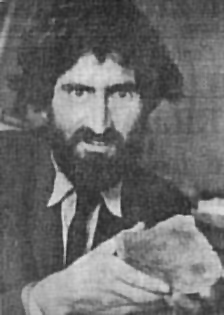Groube Les
Lesley Montague Groube 1938 - 2018
Les was a New Zealand born archaeologist. He undertook his undergraduate and graduate degrees at Auckland completing one of the first master’s degrees in archaeology. The thesis was a radical review of Maori settlement patterns drawing particularly on early European voyager accounts. It has been much cited. A published version with more material was supposed to have resulted but was never fully completed, though a draft has been circulated and is cited.
He was an early and enthusiastic practitioner of site surveying and NZAA honours that commitment today with the Groube Fieldwork Award, made biennially.
Les was appointed to a lectureship at Otago University and later at Auckland University. In that time he undertook fieldwork in New Zealand and Tonga. Excavations in New Zealand included Paeroa Village in the Bay of Islands and a garden site near to it (Peters 1975[1]), Mapoutahi Pa near Dunedin (Anderson and Sutton 1973[2]), Karitane, Orakei Basin Pa in Auckland and Otakanini Pa (Bellwood 1972[3]). Through his fieldwork and lecturing he was influential with the careers of a generation of students including Foss Leach, Helen Leach and Jean Kennedy.
Les was a big picture thinker and his early New Zealand papers show that strength. Typically his venture into Tonga brought forward a radical view of Lapita in the settlement of Polynesia.
He left New Zealand to a research role at ANU then to the University of Papua New Guinea where his research was concentrated. He subsequently was based in Britain and was involved in public archaeology in Dorset before settling in France. As his bibliography shows he has retained an interest in the Pacific.\
Two Obituaries celebrated his career in archaeology[4] [5].
References
- ↑ Peters, K. 1975. Agricultural gardens on Moturua Island in the Bay of Islands. NZAA Newsletter 18(4):171-180.
- ↑ Anderson, A. J. and D. G. Sutton. 1973. Archaeology of Mapoutahi Pa. NZAA Newsletter 16(3):107-118.
- ↑ Bellwood, P. 1972. Excavations at Otakanini Pa, South Kaipara Harbour. Journal of the Royal Society of New Zealand. 2:259-291.
- ↑ Leach, Foss and Helen Leach. 2018. Leslie Montague Groube 1937-1018 A biographical sketch. Journal of Pacific Archaeology 9(2) 1-11. Available here.
- ↑ Law, Garry and John Coster. 2018. Obituary, Leslie (Les) Montague Groube (1938-2018). Archaeology in New Zealand 61(2):7-10.
Bibliography
(Pacific oriented items only. For a full list see the Leach and Leach obituary)
1960. Mt Wellington Site Survey. New Zealand Archaeological Association Newsletter, 3(2):24-31.
1964. Settlement Patterns in Prehistoric New Zealand. Unpublished M.A. thesis. University of Auckland.
1964. Archaeology in the Bay of Islands. Pamphlet, Anthropology Department, University of Otago.
1965. Excavations on Paeroa Village, Bay of Islands. New Zealand Historic Place Trust Newsletter, 9: 5-1.
1965. Settlement Patterns in New Zealand. Occasional Papers in Archaeology 1 (Incomplete draft). Dunedin: Department of Anthropology, University of Otago.
1966. Rescue excavations in the Bay of Islands. New Zealand Archaeological Association Newsletter, 9: 108-34.
1967. Models in prehistory: A consideration of the New Zealand evidence. Archaeology and Physical Anthropology in Oceania, 2: 1-27.
1967. Note on the Hei-Tiki. Journal of the Polynesian Society 76(4): 453 - 458. On line
1969. From Archaic to Classic Maori. Auckland Student Geographer, 6: 1-11.
1970. The origin and development of earthworks fortifications in the Pacific. In R.C. Green and 1 Kelly (eds), Studies in Oceanic Culture History, Volume I. Pacific Anthropological Records 11 Honolulu: Bernice P. Bishop Museum, pp. 133-64.
1971. Tonga, Lapita pottery, and Polynesian origins. Journal of the Polynesian Society, 80(3): 278-316. On line
1975. Archaeological research on Aneityum. South Pacific Bulletin 25.3: 27-30.
1986. Waisted axes of Asia, Melanesia and Australia. In Archaeology at ANZAAS, Canberra, Ed. G Ward: Canberra Archaeological Society:168-177.
1989. The taming of the rain forests: a model for Late Pleistocene forest exploitation in New Guinea. In Foraging and Farming: the evolution of plant exploitation. Ed. David Russell Harris, World Archaeological Congress Southampton, England: 292-304.
1993. 'Dig up those moa bones, dig': Golson in New Zealand, 1954-1961. In M. Spriggs, D.E. Yen, W. Ambrose, R. Jones, A. Thorne and A. Andrews (eds), A Community of Culture: The People and Prehistory of the Pacific. Occasional Papers in Prehistory 21. Canberra, Research School of Pacific Studies, Australian National University, pp. 6-17.
1993. Contradictions and malaria in Melanesian and Australian prehistory. In A Community of Culture: The People and Prehistory of the Pacific. Eds. M. Spriggs, D. E. Yen, W. Ambrose, R. Jones, A. Thorne and A. Andrews. Canberra: Department of Prehistory, Research School of Pacific Studies, Australian National Museum, Occasional Papers in Prehistory 21: 164-86.
1996. The geometry of the dead. In Oceanic culture history: essays in honour of Roger Green. Eds. Janet Davidson, Geoffrey Irwin, Foss Leach, Andrew Pawley and Dorothy Brown. New Zealand Journal of Archaeology Special Publication: 133-65.
1996. The impact of diseases upon the emergence of agriculture. In The Origins and Spread of Agriculture and Pastoralism in Eurasia. Ed. David R. Harris, UCL Press: 101-129.
2004. Before NZAA and after 2004. In Digging into history: 50 years of the New Zealand Archaeological Association. Ed. M Campbell. Archaeology in New Zealand 47(4):108-111.
- and R.C. Green, 1959. Site survey of South Kaipara Head: Preliminary results. New Zealand Archaeological Association Newsletter, 2(2): 8-13.
- and J. Chappell. 1973. Measuring the difference between archaeological assemblages. In The Explanation of Culture Change; Models in Prehistory. Ed. Colin Renfrew, University of Pittsburgh Press: 167-184.
- John Chappell, John Muke and David Price. 1986 A 40,000 year-old human occupation site at Huon Peninsula, Papua New Guinea. Nature 324, 453 - 455, 04 December 1986.
